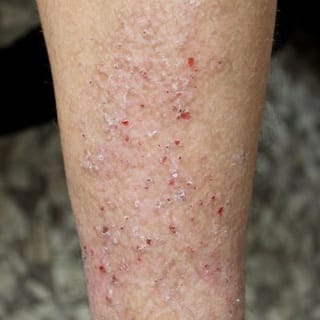 Lichen simplex chronicus is a condition where repeated scratching or rubbing of a site creates a localized, itchy, thickened, leathery patch of skin. Lichen simplex chronicus can present as a solitary lesion or as multiple lesions—usually in areas that are easy to reach. The most commonly involved sites include the scalp and neck, groin (scrotum or vulva), forearms, shins, or ankles. The condition most commonly affects women between the ages of 30 and 50. It can occur in individuals without other medical or skin problems. However, it can also occur in patients with underlying psychiatric conditions (anxiety), itchy skin conditions (eczema), or other systemic diseases associated with itching. Treatment involves breaking the itch-scratch cycle. Antihistamines, topical medications, and intralesional steroid injections are commonly used therapies.
Lichen simplex chronicus is a condition where repeated scratching or rubbing of a site creates a localized, itchy, thickened, leathery patch of skin. Lichen simplex chronicus can present as a solitary lesion or as multiple lesions—usually in areas that are easy to reach. The most commonly involved sites include the scalp and neck, groin (scrotum or vulva), forearms, shins, or ankles. The condition most commonly affects women between the ages of 30 and 50. It can occur in individuals without other medical or skin problems. However, it can also occur in patients with underlying psychiatric conditions (anxiety), itchy skin conditions (eczema), or other systemic diseases associated with itching. Treatment involves breaking the itch-scratch cycle. Antihistamines, topical medications, and intralesional steroid injections are commonly used therapies.
Disclaimer:
The information on this website is provided for educational and information purposes only and is not medical advice. Always consult with a licensed medical provider and follow their recommendations regardless of what you read on this website. If you think you are having a medical emergency, dial 911 or go to the nearest emergency room. Links to other third-party websites are provided for your convenience only. If you decide to access any of the third-party websites, you do so entirely at your own risk and subject to the terms of use for those websites. Neither Davidson Dermatology, nor any contributor to this website, makes any representation, express or implied, regarding the information provided on this website or any information you may access on a third-party website using a link. Use of this website does not establish a doctor-patient relationship. If you would like to request an appointment with a health care provider, please call our office at (843) 216-3376.



